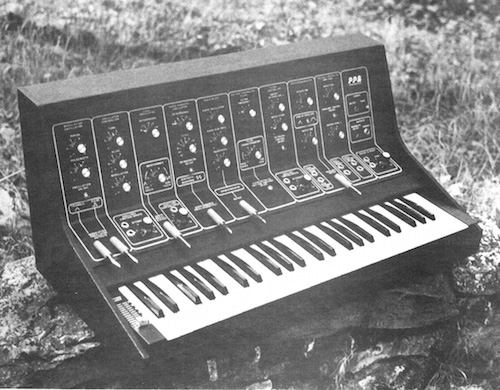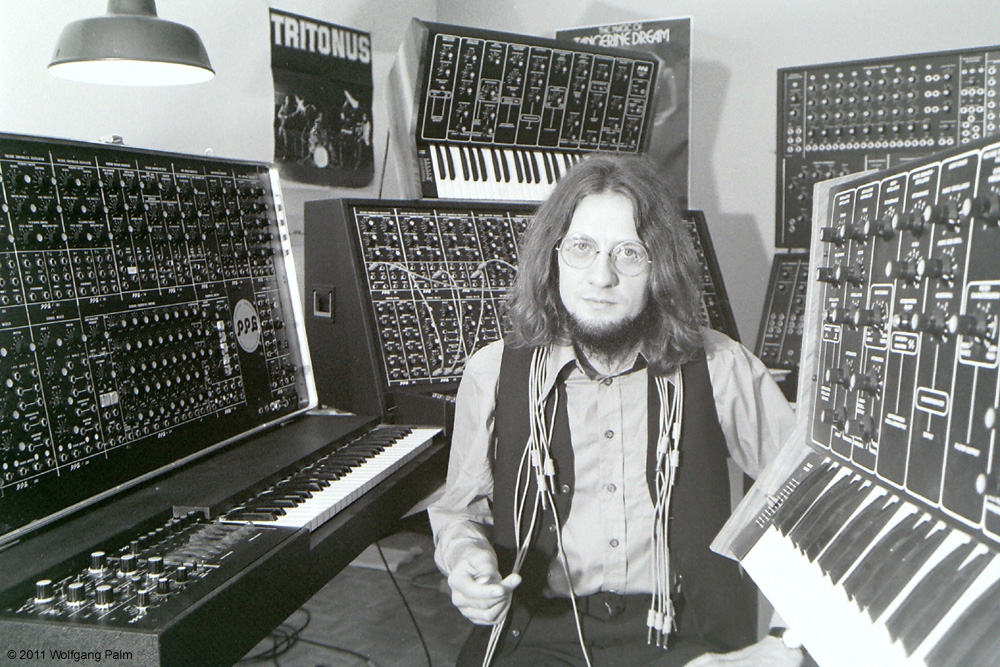The PPG Story
In 1974 I had finished my studies. My last band had split up (the drummer wanted to play more rock music). Okko had the idea to do a band with me which would make music somewhat like Kraftwerk (who were 2 at the time). This would have appealed to me, but in the end I decided to invest my full time and energy into developing the synthesizers and their production.
I had already sold a few small mooglike units. The minimoog was sold at a price of about 8000 DM (which when converted was about 4000 USD in Germany, it was probably cheaper in the states) My "compact synthesizer" was sold for about 2000 DM. Word spread fast.Naturally I was fascinated with the principle of the "patch cords", with which one could wire each output with any input. But how would this come to work with a small synth? I had the crazy idea to endow my synth with patchcables, which one could pull out of the chassis and plug into any of the inputs. If the connection wasn't needed anymore the cable would be pulled back into the chassis mechanically.
 In this way modulations could be done which weren't possible on the minimoog. (these were admittedly mostly effects which didn't justify the complexity of using patchcords) This was why the next model only had a few switches with which one could activate the most required connections. That was the PPG 1002.
In this way modulations could be done which weren't possible on the minimoog. (these were admittedly mostly effects which didn't justify the complexity of using patchcords) This was why the next model only had a few switches with which one could activate the most required connections. That was the PPG 1002.
At the same time I had started to build modules. All this was built after the moog-modular-system, because I would have loved to own a moog myself. At that time I had already built a Pitch-to-Voltage converter with which one could trigger wind instruments. Some professional musicians like Klaus Doldinger and Charly Mariano had already tried this but with fast playing had the problem of the frequency follower to start lagging. So this was still rather disappointing.
There was also a version for guitarists. "Toto Blanke" was well known for using it on his LP "Electric Circus" where he used it very nicely. I was at the recording sessions in the studio and was able to show him some tricks with the modular system. On this occasion I also got to know Jasper van't Hof who later demonstrated PPG units on exhibitions. (a true delight!)
The company PPG consisted of me, a salaried employee and some part time employees. The small synths sold rather well and we also sold a modular system from time to time. It was just enough to live from. (From this period dates a common picture of me, which we had made for advertisement in a regional music magazine)
PPG was located in an old mechanics workshop on the 5th floor with no elevator. We had a winch on the outside like was used in old warehouses for heaving up heavy stuff. We had no heating but an old oil stove. Therefor the rent was cheap.
I then had gotten contact to Heinz Funk, who did the sales and distribution for moog in Germany. He was a very serious, older Man who had many contacts to broadcasting corporations and film-studios. At this stage the production of modular systems by moog in the USA was already fading away, because more and more competition was coming from Japan and Robert Moog wanted to concentrate more on the Polymoog.
One day Mr. Funk asked me if I could help out with orders he received from theaters and such and if I could for example do the final assembly for cabinetts, powersupply and some modules. It was in this unexpected manner that I had gotten some very nice errands. One day we had a huge system with a very noble wooden console, which a carpenter had crafted in that same building. It was made for a theater and should be delivered to the customer. We asked ourselves how to transport this thing down the 5 stories of a very narrow staircase. Without further ado we used a rope to hoist the thing down to ground level by using the old winch on the outside of the building. The associate from Studio Funk almost had a nervous breakdown during this activity.
1974 hatte ich mein Studium abgeschlossen und meine letzte Band hatte sich aufgelöst (der Drummer wollte mehr rockige Musik spielen). Okko hatte die Idee, eine Band mit mir zusammen zu gründen, die ähnlich wie Kraftwerk (damals noch zu zweit) Musik machen könnte. Das hätte mich schon sehr gereizt, aber ich habe mich dann letzten Endes dafür entschieden, meine volle Kraft in die Synthesizer-Entwicklung und Herstellung zu stecken.
Ich hatte nun schon einige kleine moog-ähnliche Geräte verkauft. Der minimoog kostete damals ca. 8000 DM (umgerechnet ca. 4000 USD in Deutschland, in den USA war er bestimmt günstiger zu bekommen) und mein "Kompakt synthesizer" nur ca. 2000 DM. Das sprach sich schnell herum.
Ich war natürlich vom Prizip der "Patch Cords" fasziniert, bei dem man jeden output mit irgeneinem input verbinden konnte. Aber wie konnte man das bei einem kleinen Synth zum Einsatz bringen?
Ich kam dann auf die verrückte Idee, den Synth mit Klinkenkabeln auszustatten, die man aus dem Chassie herausziehen und in einen der Inputs stöpseln konnte.
Wenn man die Verbindung nicht mehr benötigte, wurde das Kabel über eine Mechanik wieder ins Gerät zurückgezogen.
Auf diese Art konnte man Modulationen machen, die mit dem minimoog nicht möglich waren (es waren allerdings überwiegend Effecte, die den Aufwand der patch-cords kaum rechtfertigten).
Daher hatte das nächste Modell dann nur ein paar Schalter, mit denen man die am häufigsten gebrauchten Verbindungen schalten konnte. Das war der PPG 1002.
Gleichzeitig hatte ich angefangen, Module zu bauen. Das ganze war dem moog-modular-system nachempfunden - schon deshalb, weil ich am liebsten selbst einen moog gehabt hätte!
Ich hatte zu der Zeit schon einen Pitch-to-Voltage-Converter gebaut, den man mit einem Blasinstrument ansteuern konnte. Einige Profi Musiker wie Klaus Doldinger und Charly Mariano haben das auch mal angetestet, aber da bei schnellem Spiel der Frequency Follower nicht hinterher kam, war das ganze dann doch unbefriedigend.
Es gab auch eine Version für Gitarristen, und ein bekannterer war "Toto Blanke", der das sehr schön auf seiner Platte "Electric Circus" eingesetzt hat. Bei den Aufnahmen im Studio durfte ich dabei sein und konnte ihm ein paar Tricks mit dem Modulsystem zeigen.
Bei der Gelegenheit lernte ich auch Jasper van't Hof kennen, der später für PPG auf der Messe die Geräte demonstriert hat (ein wahres Vergnügen!).
Die Firma PPG bestand nun aus mir, einem festen Mitarbeiter sowie einigen Teilzeit-Leuten. Die kleinen Synths verkauften sich ganz gut, und ab und an mal ein Modulsystem - man konnte gerade davon leben (aus dieser Zeit stammt auch das weit verbreitete Foto von mir, das wir als background für eine Anzeige in einem regionalen Musikmagazin gemacht hatten).
 Die PPG-Arbeitsräume lagen in einer ehemaligen Mechaniker-Werkstatt im 5. stock (ohne Fahrstuhl). Dafür war aber aussen eine Winde, wie man sie früher in alten Lagerhäusern zum Lasten aufziehen gehabt hat. Es gab keine Heizung, nur einen ölofen, aber die Miete war gering.
Die PPG-Arbeitsräume lagen in einer ehemaligen Mechaniker-Werkstatt im 5. stock (ohne Fahrstuhl). Dafür war aber aussen eine Winde, wie man sie früher in alten Lagerhäusern zum Lasten aufziehen gehabt hat. Es gab keine Heizung, nur einen ölofen, aber die Miete war gering.
Ich bakam dann Kontakt zu Heinz Funk, der den moog-Vertrieb für Deutschland hatte. Er war ein sehr seriöser (im Vergleich zu mir älterer) Herr, der viele Kontakte zu Rundfunkanstalten und Filmstudios hatte. Zu dem Zeitpunkt war die Produktion der Modular-Systeme bei moog in den USA bereits am Ausklingen, da immer mehr Konkurrenz aus Japan kam, und Robert Moog sich auf den Polymoog konzentrieren wollte.
So kam es, dass Herr Funk mich eines Tages fragte, ob ich nicht bei Bestellungen, die er von Staatstheatern usw. hatte, aushelfen könnte und z.B. die Kabinette mit dem Powersupply, einige Module sowie die Endmontage für ihn machen könnte. So hatte ich ganz unverhofft ein paar schöne Aufträge hinzubekommen.
Eines Tages hatten wir ein riesiges System mit einer sehr edlen Holzkonsole, die ein Tischler im gleichen Gebäude gearbeitet hatte, fertiggestellt. Es war für ein Staatstheater und sollte nun ausgeleifert werden.
Wir überlegten, wie wir das Teil durch das schmale Treppenhaus die 5 Etagen runtertransportieren sollten und haben es dann kurzerhand mit einem dicken Tau an der alten Winde herabgelassen! Der Mitarbeiter vom "Studio Funk" hat bei der Aktion fast einen Nervenzusammenbruch erlitten.